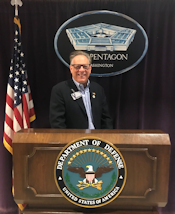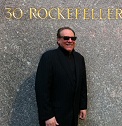NanoBusiness Alliance Interview – James M. Hussey, Chief Executive Officer, NanoInk, Inc
Posted on November 3rd, 2010 | No Comments »
In this month’s interview, we talk to James M. Hussey, Chief Executive Officer and member of the Board of Directors of NanoInk, Inc. Mr. Hussey brings 25 years of experience in the pharmaceutical and biotechnology industry as executive, founder, investor and consultant to senior management and boards of directors. Prior to joining NanoInk, Mr. Hussey was with Ovation Pharmaceuticals, where he was a member of the senior operating committee, serving as Head of Alliances and Vice President of Corporate Development. He was President and CEO of NeoPharm, Inc., as well as a member of the Board of Directors and an investor/shareholder. In 1994, he founded Physicians Quality Care, a health care services IPA Management Company, which was sold to a public company in 1998. Prior to founding Physicians Quality Care, he was with Bristol Myers Squibb in Princeton, New Jersey, serving as General Manager as well as other positions in marketing, new business development and sales. Mr. Hussey holds a B.S. in Pharmacy from Butler University, Indianapolis, Indiana, and an M.B.A. from University of Illinois at Chicago.
In this interview, we talk to Jim about NanoInk’s technology, products and applications. We also explore how nanotech can be used to address nanotech EH&S issues and discuss the global competitive landscape. We hope you enjoy the interview. – Steve Waite
SW: Thanks for taking time out of your busy schedule to meet with us today, Jim. We are delighted to be able to speak with you. NanoInk developed and patented a paradigm-shifting technology called DipPen Nanolithography (DPN). Please give us an overview of DPN and its capabilities.
JH: Dip Pen Nanolithography was discovered by Chad Mirkin, et al at Northwestern University. DPN is the first direct write, direct deposit nanoscale fabrication technology. Unlike historical nanofabrication methods, it is possible to directly write and place a broad range of materials on a broad range of surfaces. It is now possible to directly write biologic materials at the nanoscale which has never been possible before. The new applications for DPN are growing almost on a continual basis.
SW: How does NanoInk’s DPN differ from conventional lithography like that used in the semiconductor industry?
JH: DPN is a direct write, direct deposit technology. Conventional lithographic methods use either masks or other resist technology to create nanoscale structures. The conventional lithography methods limit the materials used and applications that can be developed. These methods have very little relevance for biologic applications or materials.
SW: You and your colleagues have been focused on developing revenue-generating products and applications with your technology. What are NanoInk’s main products and applications?
JH: We currently have nine products and services in the marketplace. The products include our NanoGuardian products, our DPN-5000 and NLP-2000, NanoProfessor Nanotech Education program, NanoArray Kits and Nanoscale Contract Services.
SW: Counterfeiting is a large and growing problem in the pharmaceuticals industry. Tell us more about NanoInk’s Nanoguardian product and how it is being used to combat pharma counterfeiting.
JH: Most security experts believe product diversion leads to produce counterfeiting. Pharmaceutical product counterfeiting leads to theft of pharmaceuticals. According to many sources, each of these criminal activities is increasing at an alarming rate. NanoGuardian technology adds nothing to the product and can be placed on a pharmaceutical product (capsule, vials, tablets, syringes) at a very fast rate for a penny a dose. This allows tremendous levels of forensic information to be placed on each dose of medication without exposing the patient to any additional material. Unlike package level security features, it is impossible to separate the security from the product. At the same time, NanoGuardian technology can work with all current on package security to offer a layered protection for the pharmaceutical product.
SW: When you look at NanoInk’s nanofabrication business, what are the major opportunities you see during the next 3-5 years?
JH: I believe the development of nanoarrays for proteomics and genomics will be a major driver of this business. I believe that nanoscale arrays will quickly replace microarrays and microtitre wells due to performance and cost advantages. A second business will be cell based in vitro assays. DPN is unique in creating sub-cellular structures and a broad variety of surfaces. The ability to create sub-cellular structures for a broad variety of cell types will improve the performance, reproducibility and cost of cell based in vitro assays.
SW: NanoInk’s nano arrays business is enabling nanobio discovery. What type of work is being done with these products and services?
JH: We currently have customers using nanoarrays for both proteomic and genomic applications. Nanoarrays (1 micron diameter features) use 1 billion times less fluid than conventional microarrays. Sample fluid volumes are also 50-100 times less than conventional microarrays. In addition, nanoarrays can be offered in a high throughput assay format with 48 or 96 subarrays of 48 tests each. This format is SBS compatible with all current robotic handling systems in the market.
SW: Nanotech education is near and dear to our heart. Tell us more about NanoInk’s NanoProfessor product. How is it being received by customers?
JH: One of the four goals of the Nanotech National Initiative Strategic Plan is to train a US-based nanotechnology workforce. It is clear this training has not yet occurred. Most of the Green Technology jobs ended up overseas because we had not trained a US workforce. The NanoProfessor was a response to that strategic goal within NNI. The NanoProfessor program is a “turn-key” educational solution for 2 and 4 year colleges. It is not aimed at graduate programs in education which have already been developed.
SW: You’ve licensed your technology to many universities around the world. What kind of work is being done today with it?
JH: There is a lot of innovative biology work being done with DPN around the world. DPN has a unique role in solid state biology. The ability to create surface structures and environments for biology applications is unique to DPN. Fluidic handling has also been a real challenge in biology. Using DPN, it is possible to work with fluidics down to the attaliter (1×10-21 L) range as compared to nanoliters (1×10-7 L) today.
SW: There’s been a lot of research conducted at the intersection of biotech and energy over the past decade. Can NanoInk’s technology play a role in helping to foster a greater convergence in developing new types of clean energy?
JH: The President’s Council of Advisors on Science and Technology has dubbed the convergence of nanotechnology, biotechnology and information systems as the “The Golden Triangle.” The convergence of these three disciplines is opening up the field of solid state biology as never before. The possibilities are endless. Remember, the greatest and most sophisticated computer in the universe is the human cell.
SW: You recently gave a talk at the NanoBusiness Alliance conference in Chicago. For those who weren’t there, can you summarize for us how nanotech can be used to address nanotech EH&S issues?
JH: There is one overriding issue today with EHS including nanotechnology EHS. It is the lack of alternative (to animal) testing methods acceptable to government regulators. Today, any expansion of EHS testing is an expansion of animal testing. This is not an ideal situation.
There are a couple of programs we have discussed. One is Live Single Cell Toxicity assays. We know if we isolate the live single cells in nanoarrays, and then expose them to any compound, the response are much more uniform and predictable. The other program is a Rodent Toxicity Assays where we can test changes in organ specific biomarkers to measure toxicity. There is no need to sacrifice the animals during this testing. It is the first example of sparing animals and still collecting EHS data.
SW: You’ve spent a lot of time talking and dealing with regulators in various government agencies. Do you get the sense they understand that nanotech can play a role in addressing nanotech EH&S issues?
JH: In order to reduce the reliance on animal testing, it is critical to have policy-makers at EPA, OSHA and FDA agree to the suitability of these testing methods. Until the regulatory agencies are comfortable with testing methods that do not use animals, there will be little use of these methods by companies testing compounds for EHS issues.
SW: NanoInk’s business has been expanding outside of the United States. Where are the biggest opportunities for NanoInk overseas today?
JH: We are seeing a lot of interest in the EU and the Far East.
SW: When you travel to other countries, do you get the sense they are becoming more competitive in nanotechnology versus the U.S.?
JH: For sure. Across the globe, the interest in nanotechnology and nanofabrication has really taken off in the last few years. I cannot think of a major country that does not have a nanotechnology initiative. The competition is very real and very high right now.
SW: In your view, what’s the biggest impediment to the development and commercialization of nanotechnology in the U.S. today?
JH: I think we need more serial entrepreneurs and venture capitalists that understand and are willing to invest and commercialize nanoscale research. Once we achieve critical commercial mass in nanotechnology, like biotechnology and information systems did, we have the opportunity to dominate nanotechnology for a long time.
SW: One more question for you today, Jim. What excites you the most about the potential of nanotechnology and NanoInk’s role in enabling nanotech products and applications?
JH: We are in the very early stages of the bio-nanotechnology industry. I believe that nanotechnology, and specifically dip pen nanolithography, is the key to understanding molecular biology.
SW: Thanks again for your time, Jim. We really enjoyed speaking with you and wish you and your colleagues at NanoInk all the best in the future.
Thank you, Jim, for a fascinating interview.
Last week I was in Rockford, IL attending the Fabricators and Manufacturers Association www.fmanet.org Board Meetings. The FMA has a new magazine, Green Manufacturer www.greenmanufacturer.net that I highly recommend. The September/October 2010 issue has a great article http://www.greenmanufacturer.net/article/tc/sage-supplier-lowering-costs-of-lithium-ion-batteries-for-ev-power-trains titled, “Sage Supplier: Lowering costs of lithium-ion batteries for EV power trains.”
Next week I will be participating at the Nanoinformatics 2010 www.nanotechinformatics.org Conference, November 3rd-5th at the Holiday Inn National Airport in Arlington, VA. I have the honor of introducing Nanotechnology Icon, Dr. Mihail C. Roco http://www.nsf.gov/eng/staff/mroco.jsp (National Science Foundation) at the banquet dinner on Wednesday, November 3rd.
I hope to see many of you in Arlington, VA next week.
Regards,
Vincent Caprio “Serving the Nanotechnology Community for Over a Decade”
www.nanobusiness2010.com
www.vincentcaprio.org
Executive Director
NanoBusiness Alliance
203-733-1949
vincentcaprio@nynanobusiness.org




